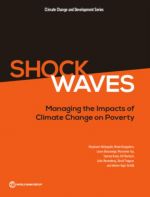Shock Waves: Managing the Impacts of Climate Change on Poverty

It has long been known that poverty makes people more vulnerable to climate change. Shock Waves sets out to empirically assess the relationship. It systematically analyses hazard data, Demographic and Health Surveys, and a huge number of existing studies to determine what patterns exist for different shocks and different regions. With its many examples drawn from local reports, its synthesis of large data trends, and its carefully referenced information, this book would be particularly useful to researchers.
The book draws overarching conclusions about the need to bolster the support systems and general wellbeing of the poor, whether those are directly linked to climate change impacts or not, and to dramatically reduce emissions in ways that do not exacerbate poverty. The potential gains from combining poverty-reducing “good development” with climate change adaptation and mitigation, according to the World Bank estimates, are as follows:
“In a pessimistic development scenario, climate change could drag more than 100 million people into poverty by 2030. This number can be reduced to fewer than 20 million, if rapid, inclusive, and climate-informed development is combined with targeted adaptation actions.” (page 179)
The three key channels of poverty explored to reach these conclusions are agriculture/ecosystems, disasters, and health.
Agriculture
Climatic and biophysical changes will affect food production in ways that harm both food producers and food consumers. The report notes that possible yield declines from climate change will vary by region: by 2080, these declines could be 23% for South Asia and 14% for Latin America, for instance. The effects on consumers are similarly varied, and are particularly worrying for low-income urban dwellers who already spend a high proportion of their income on food and do not have the option of producing their own food.
Disasters
It is clear that poverty makes people vulnerable to disasters, and disasters contribute to poverty. The figures are startling: in the year following 2009’s Cyclone Aila, unemployment in Shyamnagar, Bangladesh rose from 11 to 60 per cent, per-capita annual income fell from $15,000 to $10,000, and the poverty headcount rate grew from 41 to 63 per cent.
While the evidence on disaster exposure shows an overall relationship between poverty and risk, it is mixed for different contexts. For instance, land scarcity is associated with flood risk in urban areas, but not in rural ones. As for droughts, 85 per cent of the population examined live in areas where poor people are overexposed to droughts. Overall, “most studies find that poor people are more exposed…However, the relationship between poverty and disaster exposure is context specific and depends on the type of hazard, local geography, institutions, and other mechanisms” (page 89).
In terms of actual losses, the evidence indicates that wealthier people have greater absolute losses of assets and income, while “in relative terms, poor people always lose more than nonpoor people from floods and storms…It is these relative losses, rather than absolute numbers, that matter more for livelihoods and welfare” (page 91). The poor also depend more heavily on shared infrastructure and ecosystems, and thus the report recommends protection of these, alongside other measures.
Health
The report summarizes some major impacts: “by the year 2030, climate change could be responsible for an additional 38,000 annual deaths due to heat exposure among elderly people, 48,000 due to diarrhea, 60,000 due to malaria, and about 95,000 due to childhood undernutrition” (page 116). While acknowledging that this list does not cover all health impacts influenced by climate change, the report focuses on five areas:
1) Vectorborne diseases (malaria). Warming and changes to precipitation may encourage the spread of vectorborne diseases, reversing the progress that has been made over the past decades.
2) Waterborne diseases (diarrhoea). Climate change may increase the dangers from poor food and water quality, due to factors such as water stress, flooding and contamination.
3) Stunting. Modelling studies predict a decrease in available calories per capita for sub-Saharan Africa and South Asia, due to climate change.
4) Mental disorders. Studies have correlated higher stress, PTSD and depression with exposure to disasters.
5) Productivity loss. Individual labour productivity declines above 20–25°C, depending on the context – with potential effects at the macroeconomic level.
To counter these effects, the report calls for improvements to health systems and, ultimately, universal health coverage as an adaptation strategy.
Available from:
https://openknowledge.worldbank.org/handle/10986/22787
Further reading:
Ahammad, Ronju (2011), “Constraints of pro-poor climate change adaptation in Chittagong city”, Environment and Urbanization Vol 23, No 2, pages 503–515, available at http://eau.sagepub.com/content/23/2/503.abstract.
Hardoy, Jorgelina and Gustavo Pandiella (2009), “Urban poverty and vulnerability to climate change in Latin America”, Environment and Urbanization Vol 21, No 1, pages 203–224, available at http://eau.sagepub.com/content/21/1/203.abstract.
IPCC (2014), Climate Change 2014: Synthesis Report, Contribution of Working Groups I, II and III to the Fifth Assessment Report of the Intergovernmental Panel on Climate Change [Core Writing Team, R K Pachauri and L A Meyer (editors)], Geneva, Switzerland, 151 pages, available at http://www.ipcc.ch/report/ar5/syr/.
Book note prepared by Christine Ro
Search the Book notes database
Our Book notes database contains details and summaries of all the publications included in Book notes since 1993 - with details on how to obtain/download.
Use the search form above, or visit the Book notes landing page for more options and latest content.
For a searchable database for papers in Environment and Urbanization, go to http://eau.sagepub.com/

